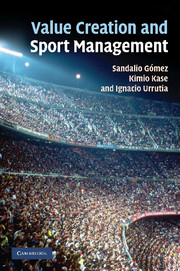Book contents
- Frontmatter
- Dedication
- Contents
- List of figures
- List of tables
- List of contributing authors
- Foreword
- Introduction
- 1 The virtuous circle of value creation in the sports industry
- 2 Value creation and performance criteria for sport entities
- 3 National context and profit strategy of the sport entity
- 4 Value creation in two of the most prestigious Spanish football clubs
- 5 The proto-image of Real Madrid
- 6 Value creation from the organizational structure of a sports entity
- Appendix I Why NGOs matter for the success of sporting events
- Appendix II Strategic evaluation of sponsorship and patronage
- Appendix III Structural characteristics of sport organizations
- Index
- References
1 - The virtuous circle of value creation in the sports industry
Published online by Cambridge University Press: 05 February 2014
- Frontmatter
- Dedication
- Contents
- List of figures
- List of tables
- List of contributing authors
- Foreword
- Introduction
- 1 The virtuous circle of value creation in the sports industry
- 2 Value creation and performance criteria for sport entities
- 3 National context and profit strategy of the sport entity
- 4 Value creation in two of the most prestigious Spanish football clubs
- 5 The proto-image of Real Madrid
- 6 Value creation from the organizational structure of a sports entity
- Appendix I Why NGOs matter for the success of sporting events
- Appendix II Strategic evaluation of sponsorship and patronage
- Appendix III Structural characteristics of sport organizations
- Index
- References
Summary
Introduction
This chapter presents an exploratory discussion of the concept of the virtuous circle. It refers to the use of chains of reaction and interaction for the furtherance of an organization's cause. We see how the players of such chains comprise different stakeholders. The virtuous circle provides the justification for and the theoretical framework of coordinated and concerted actions on account of the synergies that they will release. Sport clubs, business entities and governmental bodies may thereby greatly enhance the effectiveness and efficiency of their tasks.
This chapter describes the virtuous circle of value creation in the world of sport and analyses each component in turn (Figure 1.1). The virtuous circle is a concept predicated on the assumption that when, in sport activities, town or regional development, for example, an appropriate measure is taken it will unleash a chain of positive reactions amongst the involved stakeholders. It implies the value creation process that reinforces itself through dynamic feedback loops.
Sports events: rivalry and competition
The main objective for the organizers of sports events and the teams or individuals who take part in them is to entertain the fans and win the competition. The basic ingredients that keep any competition alive are interest, uncertainty and a passionate involvement in the outcome. To create these ingredients, there has to be fierce competition between the teams and an enduring rivalry (Figure 1.2).
Without strong, evenly matched rivals there is no uncertainty or excitement about the outcome and the fans do not feel the need to proclaim their identification with and loyalty to their team. A championship that is a foregone conclusion or that is always won by the same person or team (because the rivals are unevenly matched) loses its main attraction, which is the excitement of the result. When that happens, attendance at sports events plummets and the fans lose interest, at least temporarily.
- Type
- Chapter
- Information
- Value Creation and Sport Management , pp. 7 - 21Publisher: Cambridge University PressPrint publication year: 2010



